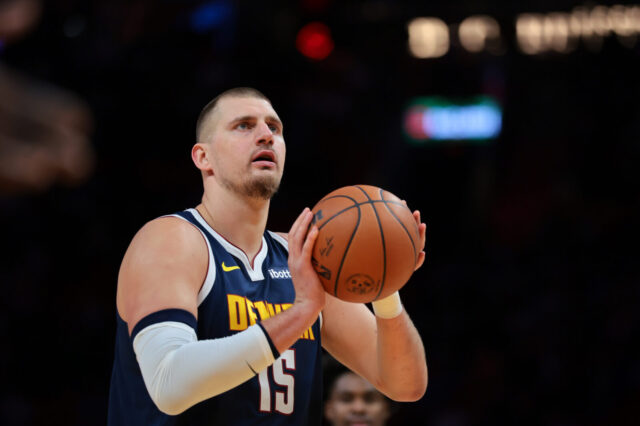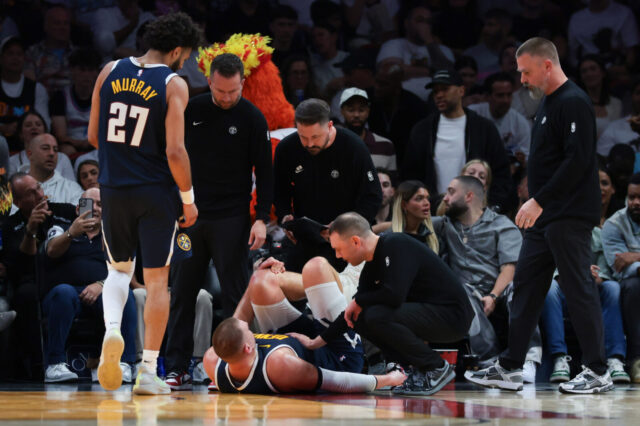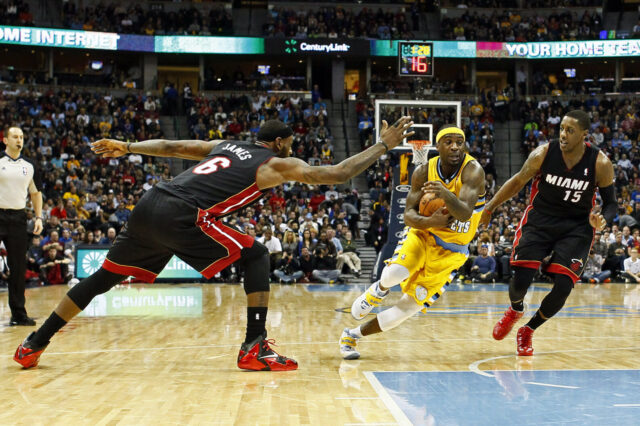Sterling Archer fans and Kenny Loggins enthusiasts can already tell where this series is going: straight into a zone. Of danger.
Partly because the Nuggets have now ceded the home court advantage in the first round they worked so hard for, and also because a simple zone defense is disrupting the entire flow of the game for the Nuggets on both ends of the floor. So why is the zone defense so effective against the Nuggets?
– It allows the Warriors to hide their weakest defenders (Curry/Jack)
– It lets the Warriors rest on defense instead of expending energy fighting through screens and picks
– It forces the Nuggets to make difficult passes, increasing the likelihood of turnovers
– It disrupts the Nuggets' rhythm on defense, as the outside missed shots results in fast break attempts for the Warriors
Of course, the Nuggets have to knock down the jumpers they have to take.
"But the Nuggets scored 117 points on 50% from the floor!", a rebuttal might begin. That's true, but from Game 1 to Game 2, the Nuggets:
– Scored fewer points in the paint and at a lower percentage of total points (52 of 97 in game 1, 50 of 117 in Game 2)
– Attempted 10 more three pointers (16 in game 1, 26 in game 2)
– Scored nearly half as many fast break points (15 in game 1, 8 in game 2)
– Turned the ball over four more times (11 in game 1, 15 in game 2)
– Committed four more personal fouls (18 in game 1, 22 in game 2)
Simply put, the Nuggets took many more attempts in the half court against a set defense on jump shots that they are not good at converting, turning the ball over and fouling more frequently in the process. Zone defense is also causing the Nuggets to let the Warriors leak out in transition, as long shots let the Warriors' guards start breaking as soon as the Nuggets put up the attempt – look no further than the 14-8 fast break points and 36-26 rebounding advantage for the Warriors in Game 2.
The only reason the Nuggets even shot at a 50% clip was due to the perfect shooting nights from Kenneth Faried (1-1), JaVale McGee (3-3) and Evan Fournier (1-1). All five of their shots came in the paint and/or less than 10 feet from the rim. Andre Miller (6-9) made his good buckets on post-ups, a lone nifty 14 foot jumper or on driving old man moves to the paint – him knocking down two of three three pointers was nice, but absolutely not something I want to see him attempting regularly. Anthony Randolph (5-6) had some great shots in the paint in the fourth. Excluding Andre’s threes, the Nuggets made 13 attempts in the paint on 15 shots between 5 players.
Meanwhile,Ty Lawson (8-17), Wilson Chandler (4-15) and Corey Brewer (6-16) shot less than 43% combined from the floor. Of those 48 attempts, 29 shots came from outside the paint between 3 players. They made 9 of them – five by Lawson, three by Brewer, and just one by Chandler.
Although Game 1 saw some switches between man and zone defense throughout the game, Game 2 saw Mark Jackson employing a 2-3 and 1-2-2 zone defense from the tip of the jump ball. Aside from some excellent early takes by Andre Iguodala – who provided the blueprint on beating the zone some of the team wadded up and threw into the trash – Ty Lawson, Wilson Chandler and Corey Brewer built a pile of bricks.
Those three largely pounded the ball around the perimeter, forced themselves into difficult attempts with the shot clock winding down, turned the ball over or took a number of ill-advised threes, playing right into the Warriors' strategy: make a bad jump shooting team take bad jump shots.
It’s not like this is the first time we’ve seen a zone defense employed to great effect against this Nuggets team. In their contests in the regular season against the Mavericks, the Nuggets were repeatedly flustered by the “matchup zone” employed by Rick Carlisle, similarly forcing the Nuggets into difficult shots. Other than their first bout in which Danilo Gallinari scored 39 points on a barrage of threes, the Nuggets needed a last-second Andre Iguodala layup – like Andre Miller’s in Game 1 – to win their second game against the Mavericks, and lost the third in overtime by three points.
So how do the Nuggets beat this zone defense and force the Warriors back into a much more amenable man-to-man? For a team with a "random offense" and without many set plays, in a few words: dribble penetration and a motion offense. Below, I've included two examples of how the Nuggets used motion by Andre Iguodala and Wilson Chandler to break down the zone successfully (the first video courtesy of our very own Nate Timmons!):
In this video, Andre Iguodala receives the ball on the far left wing from Ty Lawson. The rest of the Nuggets except Wilson Chandler and Kosta Koufos are spaced around the perimeter. As Iguodala starts his drive, Chandler screens Klay Thompson, then sits at the high post, forcing Harrison Barnes to switch. Iguodala’s drive around Barnes then forces help from Klay Thompson, who leaves Chandler. Chandler receives a bounce pass from Iguodala and throws it down over Andrew Bogut.
In the second video (starting at 0:07), the motion is even simpler – Festus Ezeli is preoccupied with McGee on the low block, Thompson is unable to stick with Iguodala off the dribble, and by the time Ezeli recognizes that he’s out of position it’s too late. Despite this clear success in attacking the zone through penetration off the high elbow, the Nuggets let themselves be content with long bricks and essentially shot themselves out of the game.
Frankly, we're not talking about implementing a triple post offense or asking the Nuggets to suddenly start pulling out playbooks full of X's and O's. The very simple truth is that a zone should be beaten easily by the athleticism of this Nuggets team. Ty Lawson and Andre Iguodala especially must do a better job breaking down their defenders by attacking the "gaps" created by the zone. Simultaneously, Corey Brewer, Wilson Chandler and Evan Fournier must screen, then cut to the open areas – especially the high post – to position themselves to receive a pass off the drive.
The end goal should be to force the Warriors to return to a man-to-man defense, where the Nuggets excel at driving, drawing fouls, and getting good looks in the paint. If they can't, the Nuggets better start making every one of those outside jumpers.
***
TiqIQ’s job is to find you the best deals and seller on the market, and for Nuggets tickets, you may want to check out Charged.fm.


